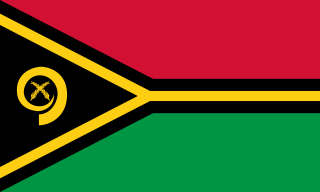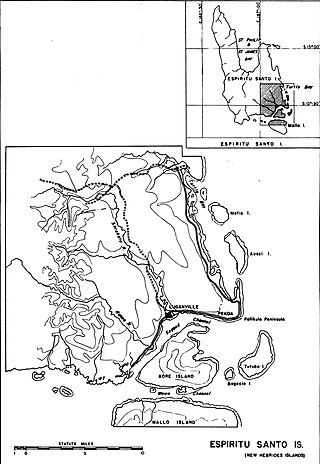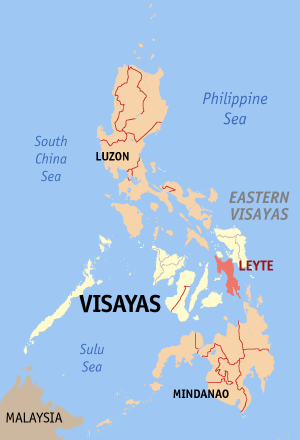
Vanuatu, officially the Republic of Vanuatu, is an island country in Melanesia, located in the South Pacific Ocean. The archipelago, which is of volcanic origin, is 1,750 km (1,090 mi) east of northern Australia, 540 km (340 mi) northeast of New Caledonia, east of New Guinea, southeast of Solomon Islands, and west of Fiji.

Espiritu Santo is the largest island in the nation of Vanuatu, with an area of 3,955.5 km2 (1,527.2 sq mi) and a population of around 40,000 according to the 2009 census.

A Quonset hut is a lightweight prefabricated structure of corrugated galvanized steel with a semi-circular cross-section. The design was developed in the United States based on the Nissen hut introduced by the British during World War I. Hundreds of thousands were produced during World War II, and military surplus was sold to the public. The name comes from the site of their first deployment at Quonset Point at the Davisville Naval Construction Battalion Center in Davisville, Rhode Island.

Luganville is the second largest city in Vanuatu after the capital Port Vila; it is located on the island of Espiritu Santo and has a population of 18,062 as of the 2020 census. Those on Vanuatu's northern islands who regard Luganville as their big city, particularly indigenous populations, call it Santo; rural residents of Espiritu Santo call it Kanal. Luganville served as a major base of operations for American troops during World War II.
Port Olry is a small Francophone village on the island of Espiritu Santo in the Sanma Province of Vanuatu, with a population of 1,300, as estimated in 2009.

SS President Coolidge was an American luxury ocean liner that was completed in 1931. She was operated by Dollar Steamship Lines until 1938, and then by American President Lines until 1941. She served as a troopship from December 1941 until October 1942, when she was sunk by mines in Espiritu Santo in the New Hebrides at the Espiritu Santo Naval Base, part of current-day Vanuatu. President Coolidge had a sister ship, SS President Hoover, completed in 1930 and lost when she ran aground in a typhoon in 1937.

Santo International Airport is an airport in Luganville on Espiritu Santo in Vanuatu. The airport used to be called Santo-Pekoa International airport until it was renamed in the Vanuatu AIPV amendment released on 16 June 2021. Airports Vanuatu Limited provides aviation services for the airport.

Aore Island is an island in Sanma Province, Vanuatu. It is located opposite Luganville on Espiritu Santo and has an area of 58 square kilometres (22 sq mi). The estimated terrain elevation above sea level is some 89 metres (292 ft).
Araki is a small rocky island with an area of 2.5 km², located 3 miles off the southern shores of Espiritu Santo, which is the largest island in the nation of Vanuatu.

The Coconut War was a brief clash between Papua New Guinean soldiers and rebels in Espiritu Santo shortly before and after the independence of the Republic of Vanuatu was declared on 30 July 1980.

Luganville Airfield or Bomber Field #3 is a former World War II airfield on the island of Espiritu Santo in the New Hebrides Islands at the Espiritu Santo Naval Base.

Aore Adventist Academy is a coeducational Christian secondary school in Aore, Vanuatu. It first opened in 1927 as 'New Hebrides Training School.' Its educational status varied over the decades. In 1974, the Aore School was upgraded to that of a high school, and was renamed Aore Adventist High School. It was previously Parker Missionary School. In 1994, the school's board changed the name to Aore Adventist Academy.

Turtle Bay Airfield or Fighter Field #1 is a former World War II airfield on the island of Espiritu Santo in the New Hebrides Islands at the Espiritu Santo Naval Base.

Luganville Seaplane Base is a former World War II seaplane base in the Segond Channel between the islands of Espiritu Santo and Aore Island in the New Hebrides Islands at the Espiritu Santo Naval Base.

Talua Theological Training Institute, formerly known as Talua Ministry Training Centre, is a Bible College in Vanuatu, run by the Presbyterian Church of Vanuatu. It is located near Luganville on the island of Espiritu Santo.
The Sarakata is one of the longest rivers of Vanuatu. It flows into Velit Bay to the west of Luganville on the southeast of the island of Espiritu Santo. Unity Park on the Segond Channel near the mouth of the river was the location of John F. Kennedy's PT-109 base while awaiting transfer to the Solomon Islands during World War II. The Japanese are planning a hydroelectric power station in the vicinity.

Squatting in the Republic of Vanuatu is the occupation of unused land or derelict buildings without the permission of the owner. After independence in 1980, informal settlements developed in cities such as Luganville and the capital Port Vila. Land in Vanuatu is either custom land owned by indigenous peoples or public land owned by the republic.

Naval Advance Base Espiritu Santo or Naval Base Espiritu Santo, most often just called Espiritu Santo, was a major advance Naval base that the U.S. Navy Seabees built during World War II to support the Allied effort in the Pacific. The base was located on the island of Espiritu Santo in the New Hebrides, now Vanuatu, in the South Pacific. The base also supported the U.S. Army and Army Air Corps, U.S. Coast Guard, and US Marine Corps. It was the first large advance base built in the Pacific. By the end of the war it had become the second-largest base in the theater. To keep ships tactically available there was a demand for bases that could repair and resupply the fleet at advance locations, rather than return them to the United States. Prior to December 7th, Pearl Harbor was the U.S. fleet's largest advance base in the Pacific. Espiritu became capable of all aspects necessary to support the Fleet's operations from fleet logistics in fuel, food, and ammunition, to transport embarkation for combat operations or returning to the continental United States. The ship repair facilities and drydocks were capable of attending to most damage and routine maintenance. Had it not existed, ships would have had to return to Pearl Harbor, Brisbane, or Sydney for major repairs and resupply. The base became a major R and R destination for the fleet.

Canal du Segond, also known as Canal Pekoa and in English Segond Channel, literally "Second Channel," separates the island of Aore from the city of Luganville on main island of Espiritu Santo, Vanuatu.

Leyte–Samar Naval Base was a large United States Navy base in the Philippines on the Islands of Leyte, Samar and the San Pedro Bay. The base was built during World War II to support the many naval ships fighting and patrolling in the South West Pacific theatre of war as part of the Pacific War. A number of naval facilities were built on the east coast of Leyte island starting October 20, 1944. The first base was built at between the city of Tacloban and Anibong Point, a mile north of the city. Headquarters for the Seventh Fleet was built at Tolosa, 10 miles south of Tacloban on Leyte. The bases were on the large San Pedro Bay in Leyte Gulf which provided safe anchorage for many ships. Due to the lack of dry ground in Tacloban a second base was built on the east side of Leyte Gulf, on the south tip of Samar, on Calicoan Island and Tubabao Island. At Samar, a large Naval Depot was built to support the Pacific War. Samar was about 50 miles across Leyte Gulf from Tacloban. All construction was done by the Navy's Seabees.



















